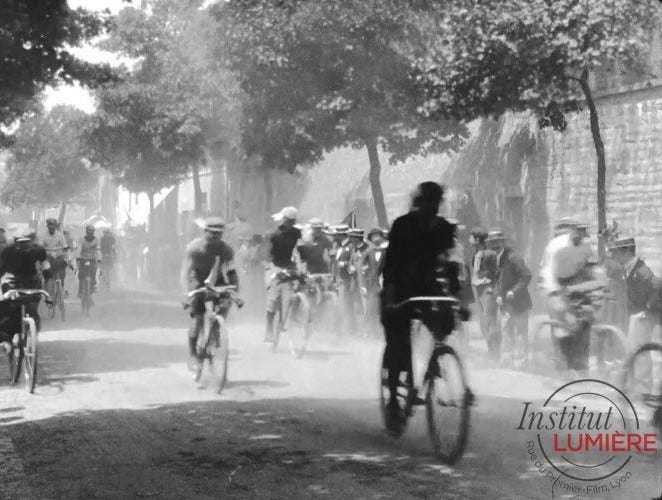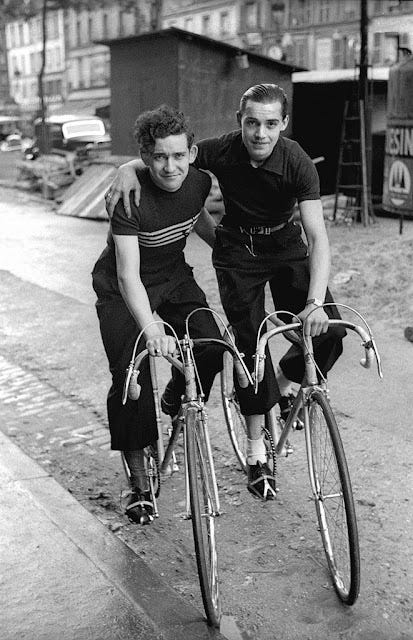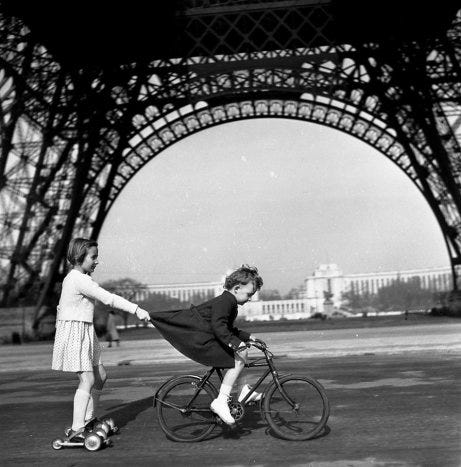On becoming a Parisian bike owner
In which I buy an e-bike, tell you what I learned in the process, and reflect on the pleasures of cycling in Paris.
Last month, I reached a new étape in becoming a bona fide parisienne. I have a beige trench coat, I’ve grown comfortable with complaining, I even (sometimes) make deadpan jokes (pince-sans-rire), and now, I commute on my very own e-bike.
That’s right: I am part of the cyclistes takeover of Paris. I’m sandwiched between pedestrians and cars. I now have an even better excuse to complain when it rains. Alongside the baby-pink helmet I’ve been sporting for over a year, I now lug my bike battery in a bright, battery-acid-green bike bag. And what’s more? J’adore ça !
Si je peux vous donner un conseil
Faites du vélib' la nuit
Sous ecstasy
La nuit
À Paris
Faites du vélib' la nuitParivelib’ — Philippe Katerine
My family has a tradition of naming cars, a habit that started when I was little. We had a gray car in New York City that we’d use to escape Manhattan on weekends. It was called “Souricette.” My parents sold it before I left middle school, and it wasn’t until 2019 that they bought another car—a white Dacia, which lives in the Basque Country. White, in Basque, is “xuri,” so naturally, the new car became “Xuricette.” (The “x” in Basque is pronounced like “sh” in English.) Later, I inherited a red (“gorri” in Basque) truck from my grandfather, which we named “Gorricette.”
When I bought my bike, I wondered if the tradition would extend to all modes of transportation, but the bike is green—just “berde” in Basque. Besides being a “boring” loan word from Spanish, it also sounds odd with the diminutive suffix: “Berdecette”… C’est un peu bof, quand même. Staying somewhat within a Basque theme, my mom suggested I name the bike after its dark green color. Pine, in Basque, is “izei.” And so, I’m thrilled to introduce Izei!
Renting vs. Buying
The journey to buying Izei was long and winding, with plenty of bumps along the way. (Anne Hidalgo’s bike lane infrastructure wasn’t quite finished in this metaphorical journey.) When I started commuting by bike in Paris, I used Velib—always the blue, electric bikes, because, as it turns out, Paris is deceptively hilly. I started biking for the freedom and convenience, not to arrive everywhere winded and sweaty. Velib and I got along fine for almost two years, until I returned to Paris after the Olympics and found the service completely unusable. It became impossible to find a blue bike at the five nearest Velib stations, and if one was available, it was uncharged, had a flat tire, its brakes screamed bloody murder at every stoplight.
Balancing work and a master’s means my time is chronométré—I no longer have 15 minutes every morning to sort out transportation. Biking saves me at least 10 minutes on all my regular commutes, so I started taking Lime bikes instead.
I downloaded the Lime app early in my Paris chapter—even before they banned the scooters! I would occasionally take a Lime bike as a last resort when running very late. They served me well. I think of them as the limousine of shared bikes: twice as heavy as a blue Velib, with an ultra-powerful motor that lets you zoom past everyone. They’re also much more expensive, costing €1 to unlock and approximately €0.30 per minute. By September and October, my frequent Lime rides were literally draining my bank account—a death by a thousand cuts. Something had to change.
Until this point, I hadn’t seriously considered buying a bike in Paris for several reasons, which I regularly recited to myself each time I cursed a Velib:
I don’t have an indoor, secure place to park my bike at home or work, so it would have to live on the street.
Bike theft is rampant in Paris. If my bike got stolen, I’d have to replace it myself.
A used road bike from Leboncoin wasn’t an option (hills!); I needed an e-bike, which is expensive.
A folding bike, which could be brought inside, would be extra expensive—and extra heavy at around 15 kilos.
No, no… buying my own bike wasn’t practical. Until it was.
After calculating the cost of commuting with Lime versus using a rental service like Veligo versus buying my own bike, I had a change of heart.
My Velib V-Max Young/Senior subscription cost €7.10/month.
Two 10-minute Lime rides per workday cost €132/month at €0.30/min, plus a €5.99 Lime Prime subscription to waive the €1 unlock fee. Total: €138/month, just for commuting!
Veligo, a bike rental service from Île-de-France Mobilités, lets Parisians test e-bikes for up to 9 months (6 months, renewable for 3 more). The base rental is €40/month, with optional insurance for theft or damages at €13.90–€19.90/month, bringing the total to €60/month (half of which can be reimbursed by employers).
Over the course of 6 months paying for Veligo with insurance, I would spend 540 euros on transportation, or 270 if I had half of it reimbursed by work. I very seriously considered this, and I think Veligo remains a fantastic option for people who want to try out biking in Paris! It’s much cheaper than Lime, and more reliable than Velib.
But ultimately, I resented the idea of spending this money on a bike that would ultimately make its way bake to an Ile-de-France mobilités warehouse. If I was going to spend money on a bike, it was going to be my own.
Insurance?
When I decided to buy my own bike, the aforementioned detractors had not gone away: I have nowhere secure to park my bike. I did examine the possibility of subscribing to bike insurance via Sharelock, which I discovered since it is through them that Veligo insures its bikes.
It would have cost about 100 euros/year to insure the bike against theft and vandalism. Sharelock has an app where you can take a photo of the bike every time you park it; this is necessary in case you need to make an insurance claim. The photo is also only valid for up to a day or two, and then you would need to re-submit the photo (i.e. you can’t just leave the bike out for weeks on end).
Eventually, I decided I would be extra careful with locking my front and back wheel every time I park, and I would get good-quality bike locks, and that this would be enough. If my bike is stolen, I may revisit insurance, but for now, I’m taking my chances. I think the cost/benefit analysis is worth calculating for everyone, so I thought I’d include this information—despite the fact that I didn’t go this route, and that my dad thinks bike insurance sounds like a ripoff.
What I have done is add a condition to my responsabilité civile insurance to cover bike accidents. You never know! If you have this sort of insurance already (which you probably should!) it might already cover bike accidents, and if not, you can just call your bank to add it. It’ll likely be a small increase in your rate, probably less than €5 monthly. This covers liability in case you cause injury to someone else or damage their property while riding your bike; it doesn’t cover damage to you or your bike.
Buying a vélo reconditionné
I purchased Izei through Upway, a company specializing in refurbished e-bikes. Besides the fact that buying a refurbished bike on Upway can be up to 60% less expensive than buying a new bike, it also has a lower emission impact! Full transparency: I found my bike by turning the search filter to “Price: Lowest to Highest.” Upway also has a quiz about what you’ll use your bike for (duration, terrain, budget, etc.) which confirmed this bike would work for me.
On an autumn Wednesday, I grabbed a Velib’ one last time (for now) and affixed my phone holder to guide me to the Upway warehouse in Gennevilliers. It took me about an hour and a half to get there—time well-spent instead of paying a delivery fee! As I picked up the bike I felt a sense of awe at having made this very grown-up purchase; at the same time, I felt a child-like sense of ineptitude, as I had neither the right questions nor vocabulary about the bike. (It happens less frequently now, but a new milieu or situation in France always comes with uncharted vocabulary. C’est la vie !)
I had taken a Vélib to Gennevilliers, but I rode my own bike back home, zipping down Boulevard de Magenta without a care in the world—until the moment I locked it up for the first time, trembling at the thought of something happening to it. Freedom comes at a cost!
At my local bike shop, En Selle Marcel, the tiny-beanie-wearing tattooed staff confirmed Upway’s reliability: Ils ne se trompent jamais ! Coming from tinkering bike enthusiasts, this was high praise. They also approved of the price I paid—I was proud of this feedback, since I am so new to bike ownership, and felt naive in their presence. Consequently, I rely on En Selle Marcel’s bike atelier for maitenance. Another good option is Decathlon, where some locations also offer repairs.
Safety & Accessories
When I had a tire issue (read: my back tire popped in Billancourt-Rives de Seine while I was biking to Versailles), my friend Charlotte gallantly biked to the closest Decathlon, where she was able to get an emergency bike kit. I learned from her how to change a bike tire on the side of the road by the Pont de Billancourt. We wiped the bike grease from our hands with toilet paper kindly gifted to us by someone taking a smoke break outside an office building with bullet holes in the glass. It turned out to be a lovely day, but I have since started carrying a bike pump, spare inner tube, tire levers, and a patch kit with me everywhere I go!
The other accessories I’ve accumulated since buying a bike include a bike bag and bike locks; I already had a helmet.
I am unwilling to let becoming a cycliste take over my whole personality, so I refuse to get a bike bag that doubles as my general bag. But I still wanted a bag that could clip onto the luggage carrier on my bike frame. I found, to my dismay, that almost all bike bags are rather expensive, save for these Cobags totes called Bike Zacs. (Please correct me if I’m wrong—I would love to know!) These crackly plastic tote bags clip onto the side of my bike and fold up perfectly in my other bags. I got the most neon color I could find (an even brighter chartreuse than my Baggu messenger bag).
I got my bike locks from Hema and the hardware store, and I don’t feel strongly about them yet, so I can’t exactly recommend them. But I did learn that most forums advise you to attach your bike to a bike rack or another immovable railing/object with a sturdy u-lock. I’ve followed this advice, and I also lock up my front wheel with an additional bike chain.
Now, when you see me rocking up to the function with my very loud and heavy green bag, you’ll know I’m being very responsible about my uninsured e-bike!
Subsidies
On BonForfait, you can find information about the subsidies available to you for buying a bike in Paris. For those of you currently studying, or else making less than approx. 10k a year, you are eligible for subsidies from the City of Paris. There are additional subsidies from the French government. All of the subsidies I’m discussing here are cumulable!
However, anyone residing in Paris is eligible for subsidies from Ile de France Mobilités! You can purchase an e-bike and get 50% of the purchase price back, up to 400 euros. Ça, c’est ma France…
A little history of biking in Paris
The concept of the bicycle began with the Draisine, also called the "Laufmaschine" (running machine), invented in 1817 in Germany. Pierre Michaux and his son Ernest Michaux, French inventors, created the first pedal-powered bicycle. This design became known as the "velocipede," though it was nicknamed the "boneshaker" due to its rough ride on cobblestone streets. When I told my friend Lucy that I often cross the Pont Neuf by bike, she said she avoids it at all costs: “It shakes my bones!” Some things never change…
The modern bicycle design was solidified with the safety bicycle in the 1880s in England. The world's first-ever bike race took place in Paris on May 31, 1868.

In the early 20th century, bicycles joined horse-drawn carriages on the streets of Paris, and Parisians frequently biked for leisure along the Seine or into the countryside. However, as cars became dominant in the post-WWII era, urban cycling in Paris declined. Bikes were often seen as outdated until the 1970s, when environmental awareness led to a renewed interest in cycling. During this time, Paris introduced its first bike lanes. In 2007, the city launched one of the world’s first large-scale bike-sharing systems with Vélib’.



Under Mayor Anne Hidalgo, biking became a key infrastructure priority in the fight against climate change and efforts to reduce traffic. In recent years, bike infrastructure has expanded exponentially, including the addition of protected bike lanes, bike highways (Réseau Express Vélo), and car-free zones. During the COVID-19 pandemic, the city accelerated the creation of “coronapistes,” temporary bike lanes, many of which became permanent due to their success.
While pedestrians and drivers often complain about cyclists in Paris, from my bike seat, it’s clear that tension runs both ways. I often see fellow cyclists ignoring red lights, but pedestrians seem equally guilty of disregarding bike lanes, particularly at intersections. Pedestrians appear to respect red lights at bike lanes less than they do at car lanes, which feels more like a “them problem” than a cycling issue.
This tension reached a tragic turning point in October when a car driver deliberately struck and killed 27-year-old Paul Varry on his bike (article in Brut). In response to cyclist protests highlighting the dangers they face, the French government created a mission contre les violences routières (“taskforce against road violence”). However, as noted by Reporterre, the taskforce’s leadership may not be well-suited to champion the protection of cyclists.
My favorite things
Le Peloton Café is nestled between the Seine and Rue de Rivoli, on the south edge of the Marais. Founded by an American and an Australian, it offers excellent American-style coffee and, best of all, PANCAKES! More than just a cozy spot for breakfast; it’s a hub for bike enthusiasts, providing bike rentals and tours of Paris in English. While I mostly go for the coffee, it’s a great place for any bike enthusiast.
I have already alluded to the archetype of the tiny-beanie-wearing, tattooed, and mustachioed bike aficionado. Le Peloton has fewer of these, but you’ll find plenty at Steel Cyclewear & Coffeeshop. If these people don’t intimidate you (good for you!), it’s worth a visit for their impressive showroom of cycling gear and accessories, alongside—you guessed it—great coffee.
Oddest of all, best for true bike nerds, is the a Bouqiniste stand entirely dedicating to cycling memorabilia. The Bouquinistes of the Seine traditionally sell paper goods—everything from leather-bound books to comic books—and often venture into trinkets for tourists. Some specialize even further, such as in specific languages, or in lefist and feminist zines such as La Lezarde. But Ludo Communier’s stand, at the foot of the Pont des Arts (on the Institut de France side), is all about bikes. Here, you’ll find vintage copies of Miroir du Cyclisme, old photographs, cycling books, etc.
But my absolute favorite thing is simply biking through Paris. It seems like cycling folds this already compact city into my back pocket. You can zoom along a réseau express vélo, making your way from La Vilette to Porte de Vanves in only 45 minutes, or meander through quiet side streets.
I especially love biking along the Seine: on the Left Bank’s upper lane, where the path is nearly uninterrupted by stoplights, or on the quieter stretches of the Right Bank, away from the bustling city center.
But nothing beats biking at night. Unlike other major cities where I’ve lived, Paris truly sleeps. When the streets grow quite, you can glide under the yellow streetlights, and it feels like this city in your back pocket belongs to you.





